To kill a mockingbird one pager – Prepare to embark on a captivating journey with “To Kill a Mockingbird: A Timeless Classic in One Page.” This comprehensive guide delves into the heart of Harper Lee’s masterpiece, offering a concise and engaging overview of its characters, setting, themes, and more.
Step into the literary world of Maycomb, Alabama, and discover the unforgettable characters and poignant themes that have captivated readers for generations.
Introduction to “To Kill a Mockingbird”
To Kill a Mockingbird is a beloved novel by Harper Lee, first published in 1960. It tells the story of Scout Finch, a young girl living in the American South during the 1930s. The novel explores themes of race, prejudice, and innocence, and has become a classic of American literature.
To Kill a Mockingbird has had a profound impact on American society. It has been praised for its honest portrayal of race relations in the South and its powerful message of tolerance and understanding. The novel has been adapted into several films and stage productions, and it continues to be taught in schools across the country.
Significance of the Novel
- It is a powerful indictment of racism and prejudice.
- It is a moving and unforgettable story about the importance of childhood innocence.
- It is a timeless classic that continues to be relevant today.
Characters in “To Kill a Mockingbird”
The characters in “To Kill a Mockingbird” are complex and well-developed, each playing a vital role in the story. They represent different aspects of human nature and explore themes of racism, prejudice, and justice.
Main Characters
| Name | Role | Traits | Significance |
|---|---|---|---|
| Scout Finch | Narrator and protagonist | Intelligent, tomboyish, curious | Represents the perspective of childhood innocence and the growth of understanding. |
| Atticus Finch | Scout’s father and a lawyer | Moral, just, compassionate | Embodies the values of integrity, empathy, and the fight against injustice. |
| Boo Radley | The mysterious neighbor | Kind-hearted, gentle, misunderstood | Represents the theme of prejudice and the importance of looking beyond appearances. |
| Tom Robinson | An African American man accused of a crime | Innocent, dignified, hardworking | Symbol of racial injustice and the struggle for equality. |
The characters in “To Kill a Mockingbird” interact in complex ways, their relationships evolving throughout the story. Scout’s relationship with Atticus is central, as he teaches her the importance of empathy and justice. Boo Radley’s friendship with Scout and Jem challenges societal prejudices.
Tom Robinson’s trial exposes the deep-seated racism in the community.
The character development in “To Kill a Mockingbird” is exceptional, as each character grows and changes in response to the events of the story. Scout’s journey from childhood innocence to maturity is particularly notable.
Setting of “To Kill a Mockingbird”
The novel “To Kill a Mockingbird” is set in the fictional town of Maycomb, Alabama, during the 1930s. The Great Depression has hit the town hard, and many families are struggling to make ends meet. The town is also deeply segregated, with whites and blacks living in separate neighborhoods and attending separate schools.
The setting of the novel plays a significant role in shaping the characters and the events of the story. The poverty and segregation that exist in Maycomb create a sense of injustice and inequality that drives much of the conflict in the novel.
The novel also explores the themes of racism and prejudice, and the setting of the novel helps to highlight the ways in which these issues are embedded in the fabric of Southern society.
Maycomb, Alabama
Maycomb is a small town in the deep South, and its inhabitants are fiercely proud of their Southern heritage. The town is steeped in tradition, and many of its residents are reluctant to change. This resistance to change can be seen in the town’s attitudes towards race and segregation.
Despite the fact that the Civil War has been over for decades, Maycomb remains a deeply segregated town. Blacks and whites live in separate neighborhoods, and they attend separate schools. The town’s white residents are quick to judge and condemn blacks, and they often treat them with contempt.
The 1930s
The novel is set during the Great Depression, a time of widespread economic hardship. The Depression has hit Maycomb hard, and many families are struggling to make ends meet. The economic hardship that exists in Maycomb creates a sense of desperation and hopelessness, and it drives many of the characters in the novel to make desperate choices.
Plot Summary of “To Kill a Mockingbird”
The novel “To Kill a Mockingbird” by Harper Lee follows the journey of Scout Finch, a young girl living in the American South during the 1930s. The story explores themes of racism, prejudice, and the loss of innocence through a series of events that shape the lives of the characters.
Major Events
- Scout’s Introduction:The novel opens with Scout, a six-year-old tomboy, introducing her family and the small town of Maycomb, Alabama.
- The Radley House:Scout and her brother, Jem, are fascinated by the mysterious Radley Place, where the reclusive Boo Radley is rumored to live.
- Tom Robinson’s Trial:Atticus Finch, Scout’s father, agrees to defend Tom Robinson, a black man accused of raping a white woman. The trial exposes the racial tensions within Maycomb.
- The Attack on Jem and Scout:After the trial, Jem and Scout are attacked by Bob Ewell, the father of the alleged victim. Boo Radley intervenes and saves the children.
- Boo Radley’s Revelation:Scout finally meets Boo Radley, revealing that he is a kind and gentle man despite his reputation.
Themes in “To Kill a Mockingbird”
To Kill a Mockingbirdis a complex and multifaceted novel that explores a wide range of themes. Some of the most important themes include racism, prejudice, and innocence.
Racism, To kill a mockingbird one pager
Racism is a central theme in To Kill a Mockingbird. The novel is set in the American South during the Jim Crow era, a time of legalized segregation and discrimination against African Americans. The novel depicts the many ways in which racism affects the lives of the characters, both black and white.
- One of the most powerful examples of racism in the novel is the trial of Tom Robinson, a black man who is falsely accused of raping a white woman. The trial is a miscarriage of justice, and Tom is convicted and sentenced to death.
The trial exposes the deep-seated racism of the white community and the ways in which the justice system is stacked against African Americans.
- Another example of racism in the novel is the treatment of Boo Radley, a white man who is shunned by the community because he is different. Boo is a kind and gentle man, but the community sees him as a monster.
The novel shows how racism can lead to fear and ignorance, and how it can prevent people from seeing the true worth of others.
Prejudice
Prejudice is another important theme in To Kill a Mockingbird. Prejudice is a negative attitude towards a person or group based on their race, religion, gender, or other characteristics. The novel shows how prejudice can lead to discrimination and violence.
- One example of prejudice in the novel is the way in which the white community treats the black community. The white community sees the black community as inferior, and they treat them accordingly. This prejudice leads to discrimination against African Americans in all areas of life, from education to housing to employment.
- Another example of prejudice in the novel is the way in which the community treats Boo Radley. Boo is a white man, but he is shunned by the community because he is different. The community’s prejudice against Boo leads them to fear and hate him, even though he has done nothing to deserve it.
Innocence
Innocence is a third important theme in To Kill a Mockingbird. Innocence is the quality of being free from guilt or sin. The novel shows how innocence can be lost in a world that is full of racism and prejudice.
- One example of innocence in the novel is the character of Scout Finch. Scout is a young girl who is growing up in the American South. She is innocent of the racism and prejudice that surrounds her, and she sees the world with a clear and open mind.
- Another example of innocence in the novel is the character of Tom Robinson. Tom is a black man who is falsely accused of raping a white woman. Tom is innocent of the crime, but he is convicted and sentenced to death.
The novel shows how innocence can be lost in a world that is full of racism and prejudice.
Symbolism in “To Kill a Mockingbird”
Symbolism is a literary device used to represent abstract ideas or concepts through concrete objects or images. In “To Kill a Mockingbird,” Harper Lee employs various symbols to enhance the story’s themes and deepen its meaning.
The Mockingbird
The mockingbird is a central symbol in the novel. It represents innocence, purity, and the destruction of something innocent and harmless. The children, Scout and Jem, are warned not to kill mockingbirds because “they don’t do one thing but sing their hearts out for us.”
However, Boo Radley, the mysterious neighbor, kills a mockingbird to protect the children from the evil Bob Ewell.
The Mad Dog
The mad dog represents the evils of racism and prejudice that permeate Maycomb. It is a rabid, dangerous animal that threatens the safety of the community. When Sheriff Tate shoots the dog, it symbolizes the need to confront and eradicate evil, even if it is difficult or dangerous.
The Radley House
The Radley house is a symbol of mystery, fear, and the unknown. It is a dilapidated, isolated mansion that is home to Boo Radley, a reclusive figure who is feared by the children. The house represents the hidden evils and secrets that exist within society, even in the most seemingly innocent places.
Literary Devices in “To Kill a Mockingbird”: To Kill A Mockingbird One Pager
Harper Lee’s “To Kill a Mockingbird” employs a range of literary devices to enhance its storytelling and convey its themes. These devices include foreshadowing, irony, and imagery.
Foreshadowing
Foreshadowing is used throughout the novel to hint at future events. For example, the description of the mockingbirds as “harmless creatures” foreshadows the unjust killing of Tom Robinson.
Irony
Irony is also used extensively in the novel. For instance, the title “To Kill a Mockingbird” is ironic because mockingbirds are symbols of innocence and harming them is considered a sin.
Imagery
Lee uses vivid imagery to create a strong sense of place and atmosphere. For example, the description of the “haunted house” on the Radley property creates a sense of mystery and foreboding.
FAQ
What is the significance of the mockingbird in the novel?
The mockingbird symbolizes innocence, purity, and the destruction of something beautiful and harmless.
How does the setting of Maycomb, Alabama, influence the story?
Maycomb’s small-town atmosphere and racial tensions shape the characters’ experiences and the novel’s themes.
What is the main conflict in “To Kill a Mockingbird”?
The main conflict is the trial of Tom Robinson, a black man accused of raping a white woman. The trial exposes the racism and prejudice that permeate Maycomb society.

